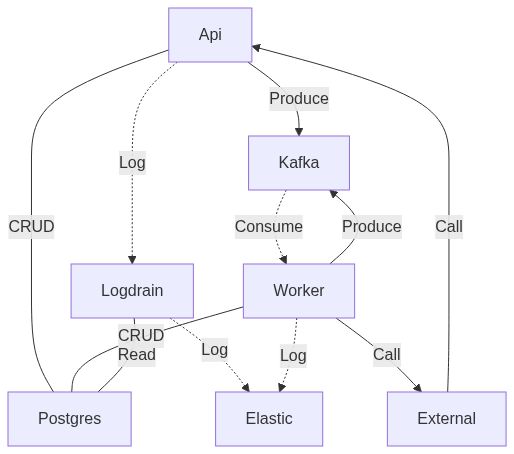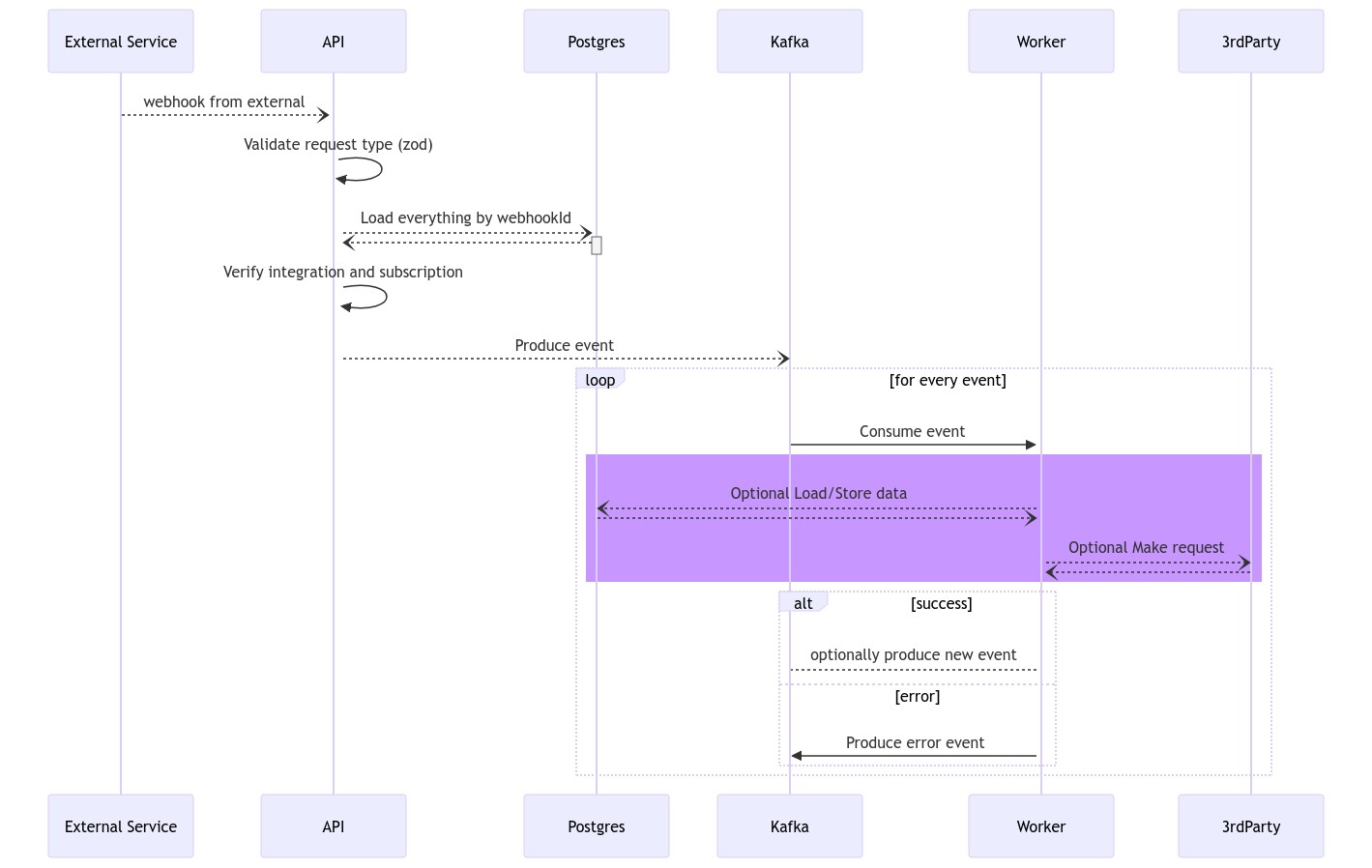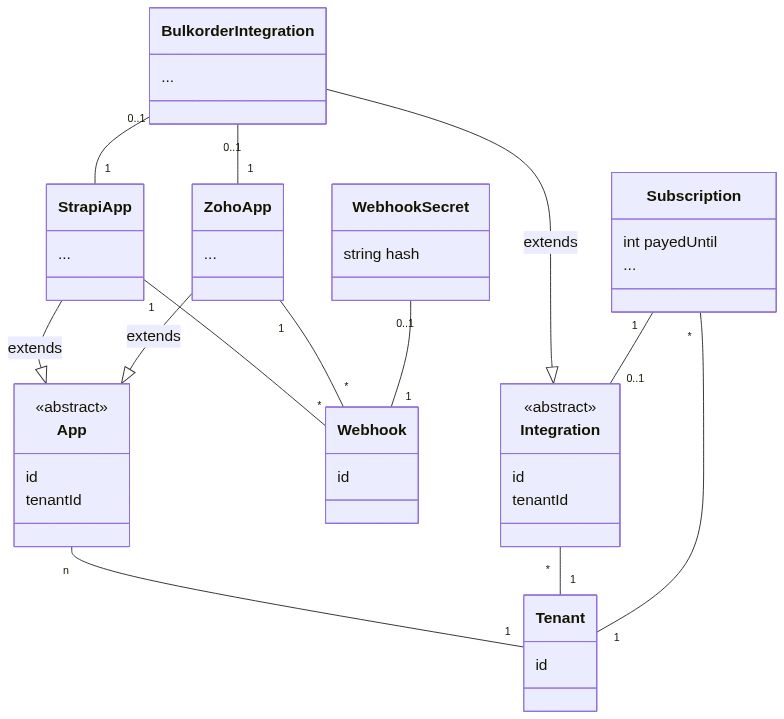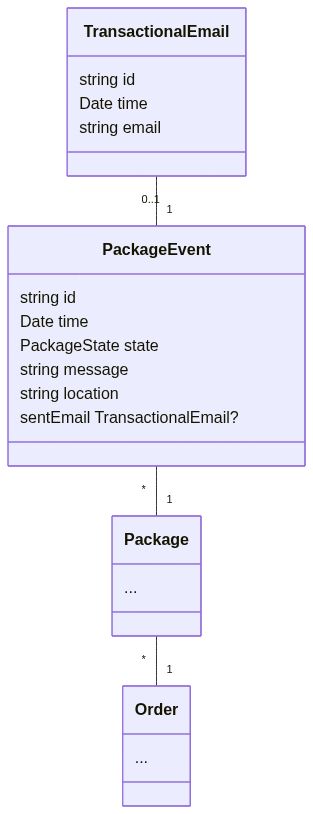Table of Contents
- Requirements
- Components overview
- Setup
- How do I get the zoho cookies?
- Glossary
- Webhooks
- Graphql API
- Typical Flow of an event triggered by an incoming webhook
- Howto: Adding a new integration
- Database
- Debugging Kafka
- Integration tests
- pnpm
npm i -g pnpm - docker
- docker-compose
- better internet :'(
- Api: Nextjs hosted on vercel to receive webhooks and run graphql server
- Logdrain: Nextjs hosted on k8s to forward logs to elasticsearch
- Kafka: Hosted on Upstash
- Worker: Nodejs container hosted on k8s, listens to events from kafka and executes integrations.
- External: Zoho, Strapi, Saleor etc, we receive webhooks and make http calls to them.
- Postgres: Our internal db in k8s
schemabase has the following integrations already in place:
- Xentral
- Zoho Books
- Zoho Inventory
- Saleor
- reviews.io
- DHL
- UPS
- DPD
- Track&Trace (custom Track&Trace solution supporting multilanguage notification emails on every package tracking update from the supported carriers)
- Braintree (pulling transaction costs)
Run install, codegen and database migration in one command:
make init- Get a cup of coffee while everything starts
make initStart a complete environmentdocker compose stop eci_apinpx dotenv-cli pnpm next dev ./services/api- Do stuff
- Once you are ready, you can run your full test suite:
5.1
make rebuild-api5.2make test
A single message in kafka/bull. An event is produced by a producer in the nextjs api or inside an EventHandler's onSuccess function.
Events are organized and durably stored in topics. Very simplified, a topic is similar to a folder in a filesystem, and the events are the files in that folder. An example topic name could be "payments". Topics in Kafka are always multi-producer and multi-subscriber: a topic can have zero, one, or many producers that write events to it, as well as zero, one, or many consumers that subscribe to these events. Events in a topic can be read as often as needed—unlike traditional messaging systems, events are not deleted after consumption.
In bull this would be a queue name.
A kafka producer is a wrapper around a kafka client that can create new messages and add them to a topic.
In bull this would be the Queue class.
Consumer and subscriber are the same thing. In Kafka terms you would call this a consumer, but redis based queues usually call it a subscription. Either way a consumer is listening on a certain topic and calling a given handler function for every new message.
In bull this would be the Worker class.
In the beginning there were only synchronisations, and we called them integrations. An integration was basically a function that could be called in response to a new message from a queue.
Now we have a little bit more logic for receiving the message and handling errors and we're merging the receiving of a message with the actual business logic, and we're calling this an EventHandler.
An event handler has to offer a single function that receives an event and can do with that whatever it wants, a callback for successful work is provided to allow different eventHandlers to be chained together via kafka.
Think of a Workflow in anwr dwh.
All webhooks are inside services/api/pages/api. Each webhook has a README.md file with further information.
The api offers a few synchronous resources such as the product datafeed. Here we simply make a request to the db and a 3rd party system and return the data.
Most endpoinst are only meant to receive an event from a 3rd party, validate the request body, load necessary data from the database and allow/disallow an action depending on whether the tenant has payed for a specific integration.
If all goes well, the api handler simply produces an event to a specific topic and returns 200 OK to the caller. At this point we have the event in our system and we can retry as many times as we need.
- Cylinder shaped elements are Kafka topics / bull queues.
- Rounded are api routes inside nextjs.
- Rectangular are EventHandlers running on the worker
The graphql api is hosted on the api service under /api/graphql. The actual implementation is inside pkg/api and currently only allows to read packages by their trackingId. However the boilerplate for authentication and modules is set up and new features can be added quickly.
There are currently two ways integrations are built.
- (Old) separate event handler and integration
- (New) combined
An example of a new integration can be found in pkg/integration-tracking/src/notifications.ts
Here the integration implements the EventHandler interface and can be plugged directly into a KafkaConsumer in the worker.
- Go to
/pkg/events/src/registry.tsand extend the Topic enum at the top of the file. - Scroll down and copy one of the
export type XXX = EventSchema<segments to add your new message type.
Create a new integration in pkg/. The CustomerNotifier can be a good starting point and I suggest copying that. (pkg/integration-tracking/src/notifications.ts).
The important part is that your new integration must implement the EventHandler interface (/pkg/events/src/handler.ts)
EventHandlers usually have a onSuccess function provided to them in the constructor. I used this to produce a new event to a different topic to be handled by a different event handler. You could add this directly into the eventHandler but that would require setting up a kafka producer and you would need to know about the topic inside your business logic.
By providing an onSuccess function to the constructor we can remove the routing logic from the business logic and handle all of it in a central main.ts file (think of sourceIndex and destIndex in anwr dwh)
// service/worker/src/main.ts
new tracking.CustomerNotifier({
onSuccess: publishSuccess(producer, Topic.NOTIFICATION_EMAIL_SENT),
// remaining config
});As you can see, we're using a helper function publishSuccess that will receive the return value of our CustomerNotifier (in this case the email address) and publish it to the NOTIFICATION_EMAIL_SENT topic. Almost all of the routing logic, which event will trigger which integration and what gets published to different topics is contained in a single file. The only implicit producer is part of the KafkaConsumer class and will produce a new event to the UNHANDLED_EXCEPTION topic in case of unhandled exceptions in your integration code. In bullmq this would be done implicitly by bull itself.
Now that you have created an eventHandler, you need to hook it up to receive events.
In services/worker/src/main.ts create a new subscriber and event handler instance like this:
Replace PackageStateTransition and Topic.PACKAGE_STATE_TRANSITION with your previously created names from step 1.
Use any unique value as groupId and simply ignore it. it's not needed once you switch kafka for bullmq.
const customerNotifierSubscriber = await KafkaSubscriber.new<
EventSchemaRegistry.PackageStateTransition["message"]
>({
topic: Topic.PACKAGE_STATE_TRANSITION,
signer,
logger,
groupId: "customerNotifierSubscriber",
});After creating the subscriber, you can add the eventHandler like this:
customerNotifierSubscriber.subscribe(
new tracking.CustomerNotifier({
db: prisma,
onSuccess: publishSuccess(producer, Topic.NOTIFICATION_EMAIL_SENT),
logger,
emailTemplateSender: new Sendgrid(env.require("SENDGRID_API_KEY"), {
logger,
}),
}),
);That's it, now the worker will start handling the new events. If you already have a producer for this topic (existing webhook or eventHandler, that produces on success), you can stop here.
Next up is producing the events from a webhook.
- Create a new api route in
services/api/v1/my/path/[webhookId]/index.ts
import {
authorizeIntegration,
extendContext,
setupPrisma,
} from "@eci/pkg/webhook-context";
import { z } from "zod";
import { HttpError } from "@eci/pkg/errors";
import { handleWebhook, Webhook } from "@eci/pkg/http";
import { env } from "@eci/pkg/env";
import {
EventSchemaRegistry,
KafkaProducer,
Message,
Signer,
Topic,
} from "@eci/pkg/events";
const requestValidation = z.object({
query: z.object({
webhookId: z.string(),
}),
body: z.object({
someField: z.string(),
}),
});
const webhook: Webhook<z.infer<typeof requestValidation>> = async ({
backgroundContext,
req,
res,
}): Promise<void> => {
/**
* If this function gets executed the request has already been validated by zod.
* So you are safe to destructure the `req` object without validating
*/
const {
query: { webhookId },
body: { someField },
} = req;
const ctx = await extendContext<"prisma">(backgroundContext, setupPrisma());
/**
* load the necessary data from the database by joining tables, starting at the webhook.
*/
const webhook = await ctx.prisma.incomingWebhook.findUnique({
where: { id: webhookId },
include: {
dpdApp: {
include: {
integration: {
include: {
trackingEmailApp: true,
subscription: true,
},
},
},
},
},
});
/**
* Verify we have all required data
*/
if (webhook == null) {
throw new HttpError(404, `Webhook not found: ${webhookId}`);
}
const { dpdApp } = webhook;
if (dpdApp == null) {
throw new HttpError(400, "dpd app is not configured");
}
const { integration } = dpdApp;
if (integration == null) {
throw new HttpError(400, "Integration is not configured");
}
/**
* Ensure the integration is enabled and payed for
*/
authorizeIntegration(integration);
ctx.logger.info("The user has something to say", {
someField,
});
const event: EventSchemaRegistry.MadeUpname["message"] = {
someField,
dpdAppId: dpdApp.id,
};
const kafka = await KafkaProducer.new<
EventSchemaRegistry.MadeUpName["message"]
>({
signer: new Signer({ signingKey: env.require("SIGNING_KEY") }),
});
const message = new Message({
header: {
traceId: ctx.trace.id,
},
content: event,
});
const { messageId } = await kafka.produce(Topic.MADE_UP_NAME, message);
ctx.logger.info("Queued new event", { messageId });
};
export default handleWebhook({
webhook,
validation: {
http: { allowedMethods: ["POST"] },
request: requestValidation,
},
});We are using a PlanetScale hosted database. Ig you want to connect to a database with prisma etc. you can use the pscale CLI:
pscale connect eci main
Just make sure, that the following variable is set correctly in your .env:
DATABASE_URL="mysql://localhost:3306/eci"
Our own database is setup in a modular way, there are 2 important types of entities: Apps and Integrations. If we could do inheritance this would be what I would build: !!!This diagram is not complete! It does not include every table in order to simplify the illustration and explain my thoughts!!!
- Tenant A single customer of ours (Pfeffer und Frost)
- App A single application configuration. Here we store connection details and other config for a 3rd party system. The idea is that a customer can add these App configs using our UI (at some point) or add them automatically via one-click installations. Afterwards they can connect these apps via
integrations - Integration The connection of 1..n applications and a tenant. (The bulkorder integration connects a strapi app with a zoho app)
- Subscription Every integration can have a subscription attached, that can hold information such billing periods and usage tracking for usage based pricing.
- Webhook Every app can have 0..n webhooks attached. This gives us a unique identifier for incoming webhooks and allows us to load the attached
app, itsintegrationand other connectedappsas well assubscriptionstate. Allowing multiple webhooks per app also makes it possible for customers to replace webhooks (and their secret) without downtime. - WebhookSecret We require an authorization header to be present with every incoming request and match its hash against a hash stored in the db.
This is a separate table because in the past we had separate webhooks tables for each app. Right now there's nothing stopping us from adding a
secretcolumn to thewebhookstable and remove thewebhooksSecrettable.
As mentioned above, inheritance is not possible in prisma, so we have to manually duplicate columns in different XXXApp and XXXIntegration tables, but the mental model should be, that all integrations behave similar and have relations to a tenant, a subscription and one or more apps. In practice this results in a few optional relations here and there that prisma requires and actually creates on its own using prisma format
For the tracking integration we added more tables to store data for later use. In the future there will be more tables to have different mapping tables etc.
Specifically for tracking we added 4 new tables:
Some fields are omitted, just check pkg/prisma/schema.prisma
Go to http://localhost:8080/ui/clusters/eci/consumer-groups for kafka-ui (started with docker-compose)
Tests are in /e2e and are loosely grouped by domain.
To execute tests, run make test (after make init)
They usually follow the same process:
- Seed database for test
- Run test
- Remove test data from 3rd party systems (especially zoho)
Connect to the testing DB (or create a new testing DB for yourself)
pscale connect eci testing
Reset the DB and seed it with mandatory test data
pnpm prisma migrate reset
Run specific tests in a folder and not all
pnpm jest pkg/integration-zoho-entities/src




